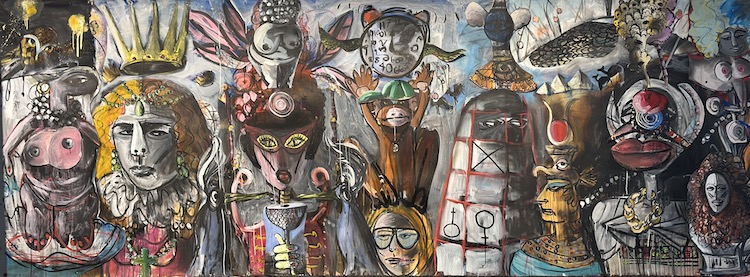Deborah Buck’s Into the Wild: To Crash is Divine at La Mama Galleria connects the thinking-through process of drawing to the loose shaping of crowds and identity. Buck’s work breaks down the boundaries between modes of cartooning and abstraction to operate as covert satire. Between her figurescapes and phase shifts of pastiche, Buck generates erased zones of gray that she then utilizes as an important formal resource. By revealing the trace and shadow of her expressive hand, she makes the evidence of her thinking and the provisional sense of communities her subject, allowing the shadows and index of drawing to form productive tension with flat color.
This transparency of process, of thinking through the hand, makes the breakdown of form function as its content. Buck’s layering acts like a metaphysical dredge that pulls the winding pathways of searching to the surface. The artist forms a dense palette of gray through gestural excess, which functions as a valuable prima materia on the surface of the paper: a primordial ambergris that is ready to resist the predominant graphic orchestration. The depth generated within each marengo apeiron is stabilized by her graphic flurry of lines and ornamental drawing. The black outline steps into flatten everything out again, producing graphic tension with the implied form underneath. Often, what is seen as a form, or a void remains pictorially ambiguous. With each event of spatial diversity, Buck allows associations to be drawn between the process and the provisional margins of the body and the crowd. It is again this distinct gray that forms rich dimensions of skin and atmosphere, that also casts everything in raking light; that Buck then generates into diverse communities of figures that flicker in and out of their form like movements through aether. It is the animation of a cartoon caught under the weight of a steamroller; the physicality of being flattened into a disk before popping back into dimensional form.
The question then is what is being reanimated? It is difficult to not see it as a kind of repossession, or a retrieval of biomorphic surrealism and the bleb shapes of early European modernism; of Guston’s early “Porch” paintings, or Picasso’s tormented women. At times it seems like Buck is personifying the smoke emitted from the pipes of Guston’s figures into their own figures, in works like House Plants (2023), where the figure is a black flurry of marks. The balloon eyes float above the red house shapes that have the eyes of Guston’s Klansmen. It is an anxious haunting, a snarl of heaving hair or tendrils that shares similar affect to the figure in Mr. Nervous (2023) which evokes a missing character from The Mr. Men Show as a red balloon of dread. While both play with the discordant and heightened sense of worry made possible through humor, they also allow the artist to explore the dramatic plasticity of image-objects, the sculptural presence and form achieved by Felix the Cat and the dimensionality of graphic black.
It is that tension, and Buck’s affinity for languages of animation and caricature, that allows for Buck to surreptitiously investigate injustice and inequality from an innocent position. Buck ventriloquizes satire through Saturday morning cartoons so that the impact of textual meaning can be delayed. BAAD depicts a dark wolf performing as a sheep, with the word “bad” written along the bottom in red, white, and blue. Heavy is the Head (2023) is one of Buck’s two largest drawings in the exhibit. It depicts a crowd where each figure forms a smash cut of history, wandering through different expanses of time and culture under the presence of a broken clock. More than just the way each figure figures themselves into the crowd, it seems to also be about displacement; about the possession of history and who defines it through institutions and museum collections.
Buck’s work enters through the same door as Carroll Dunham, but leaves out a different exit—towards a feminist lens that is deeply skeptical of the way patriarchal structures are reinforced. It is a valence of ornament and self-effacement: one that is interested in how identity is relational, and how the abjection and humor of disfiguration can form a vibrant body politic. The questioning of taste, as Sontag reminds us, is ultimately a questioning of patriarchal guise. Royal Flush (2020), far from sentimental paragon, depicts a gloopy figural mass. Arranged like puzzle pieces with phallus to the side, the intertwined figures are sacks that bulge and fold down the length of the body. It is the embarrassment of sentiment and love, viewed both from within it and exterior to it. However, it is The Judge (2020) that may reveal the real intention of the show. Who is left to hold their hand up and bear witness? It is William Blake’s adoption of the questioning lamb, the child repeating the question of “why?” repeatedly until reality becomes disfigured and the parent’s authority is exhausted; and what can be worked out on a notebook page. It is perhaps Buck’s autonomous activation of her own songs of innocence and experience.
Deborah Buck Into the Wild: To Crash Is Divine
Curated by Jennifer Baahng
at LaMama Galleria
